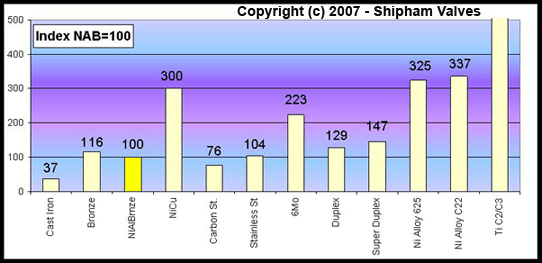Once again, the comparison is intended to be a guide. The values in graph
are a like-for-like comparison. The parameters are for a small quantity
of a medium range (say 6” gate valve body) to the same design. Prices
per kg have been adjusted by the relevant material density to ensure
that the same volume is used in each case. As valves are made to standards
with minimum wall sections this is a good approximation to reality, but
does not allow for the detail design differences that would be necessary
due to the different alloy characteristics. The data does not take into
account the economies of scale that are undoubtedly available for large
quantities in the more popular materials. An element of the quality testing
that is commonly required has been included. These are typically charges
per melt and so highly quantity dependent.

The density of bronze is greater than NAB, thus making it more expensive than NAB, although the material prices are similar per kg. The stainlesses are also denser than NAB with a similar effect. Machining prices have not been included, but in general terms this would increase the 6Mo, duplex, super duplex and Ni alloy prices relative to NAB.
A significant effect is the testing that is required to ensure the quality of the various materials. For example, for 6Mo, 22Cr and 25Cr, Shell ES/247 requires
Impact testing (not 6 Mo)
Hardness testing
Microstructural examination and ferrite phase balance (not 6 Mo)
Pitting Corrosion testing (additionally, stress corrosion cracking for 25Cr if specified)
All this is in addition to dye penetrant testing and radiography which may be required on all materials. These are required to ensure that the casting process is fully controlled and does not produce an adverse structure.
NAB can be specified with heat treatment which can help ensure that the casting corrosion properties are maintained at optimum levels, but special testing is unusual.
The overall conclusion on costs is that stronger does not mean less if the design codes are adhered to and that the cost of quality assurance is also a significant element that must not be ignored.